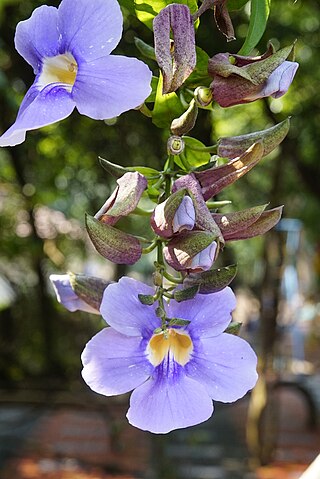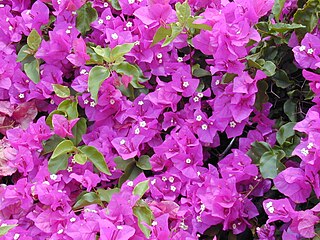
Jasmine is a genus of shrubs and vines in the olive family of Oleaceae. It contains around 200 species native to tropical and warm temperate regions of Eurasia, Africa, and Oceania. Jasmines are widely cultivated for the characteristic fragrance of their flowers. Additionally a number of unrelated species of plants or flowers contain the word "jasmine" in their common names.

Rubus phoenicolasius is an Asian species of raspberry in the rose family, native to China, Japan, and Korea.

Thespesia populnea, commonly known as the portia tree, Pacific rosewood, Indian tulip tree, or milo, among other names, is a species of flowering plant belonging to the mallow family, Malvaceae. It is a tree found commonly on coasts around the world. Although it is confirmed to be native only to the Old World tropics, other authorities consider it to have a wider, possibly pantropical native distribution. It is thought to be an invasive species in Florida and Brazil.

Ipomoea aquatica, widely known as water spinach, is a semi-aquatic, tropical plant grown as a vegetable for its tender shoots. I. aquatica is generally believed to have been first domesticated in Southeast Asia. It is widely cultivated in Southeast Asia, East Asia, and South Asia. It grows abundantly near waterways and requires little to no care.

Thunbergia is a genus of flowering plants in the family Acanthaceae. It includes 150 species native to tropical and subtropical regions of sub-Saharan Africa, Madagascar, southern Asia, New Guinea, and Australia. Thunbergia species are vigorous annual or perennial vines and shrubs growing to 2–8 m tall. The generic name honours the Swedish naturalist Carl Peter Thunberg (1743-1828).

Colubrina is a genus of about 30 species of flowering plants in the family Rhamnaceae, native to warm temperate to tropical regions of Africa, the Americas, southern Asia, northern Australia, and the Indian Ocean islands.

Thunbergia alata, commonly called black-eyed Susan vine, is a herbaceous perennial climbing plant species in the family Acanthaceae. It is native to Eastern Africa, and has been naturalized in other parts of the world.

Thunbergia laurifolia, the laurel clockvine or blue trumpet vine, is native to India and Thailand and the Indomalayan realm, the species occurs from Indochina to Malaysia.

Toona ciliata is a forest tree in the mahogany family which grows throughout South Asia from Afghanistan to Papua New Guinea and Australia.

Microstegium is a genus of African, Asian, and Pacific Island plants in the sorghum tribe within the grass family. Browntop is a common name.

Pteris vittata, commonly known variously as the Chinese brake, Chinese ladder brake, or simply ladder brake, is a fern species in the Pteridoideae subfamily of the Pteridaceae. It is indigenous to Asia, southern Europe, tropical Africa and Australia. The type specimen was collected in China by Pehr Osbeck.

Skimmia japonica, the Japanese skimmia, is a species of flowering plant in the family Rutaceae, native to Japan, China, and Southeast Asia. Growing to 6 m (20 ft) tall and wide, it is a rounded evergreen shrub with glossy, leathery leaves. It is widely cultivated as an ornamental plant in gardens and parks. Its fragrant flowers are cream-yellow or white, followed on female plants by small, round, red fruits. The plant tolerates a wide range of conditions, including frost, drought, and atmospheric pollution. It is suitable for bonsai and for Chinese gardens.

Microchloa, or smallgrass, is a genus of tropical and subtropical plants in the grass family, native to Africa, southern Asia, northern Australia, and the warmer parts of the Western Hemisphere.

Thunbergia erecta (Benth.) T. Anders., commonly known as the bush clock vine or king's mantle, is a vibrant, evergreen shrub that belongs to the family Acanthaceae. Native to the forest zone stretching from Guinea-Bissau to Western Cameroon, it has found significant cultivation worldwide due to its ornamental appeal and versatility. The plant is particularly known for its erect or scandent growth habit, reaching a notable height of up to five meters or more. This robust shrub displays a fascinating range of pale to dark violet-purple flowers that contribute to its visual appeal and broad popularity. Each flower measures between 5.0 to 7.5 cm in length, hosting a stark white tube at their core. This striking color contrast lends an undeniable charm to the plant, making it a favored choice in various garden settings and landscapes.

Trema orientale is a species of flowering tree in the hemp family, Cannabaceae. It is known by many common names, including charcoal-tree, Indian charcoal-tree, pigeon wood, Oriental trema, and in Hawaii, where it has become naturalized, gunpowder tree, or nalita. It has a near universal distribution in tropical and warm temperate parts of the Old World, with a range extending from South Africa, through the Middle East, the Indian subcontinent and southern China to Southeast Asia and Australia.

Fallopia baldschuanica is an Asian species of flowering plant in the knotweed family known by several common names, including Russian-vine, Bukhara fleeceflower, Chinese fleecevine, mile-a-minute and silver lace vine. It is native to Asia, and is growing wild in parts of Europe and North and Central America as an introduced species.

Rubus ellipticus, commonly known as ainselu, golden evergreen raspberry, golden Himalayan raspberry, or yellow Himalayan raspberry, is an Asian species of thorny fruiting shrub in the rose family. It's native range stretches from the Indian subcontinent to southern China and Indochina and the Philippines.

Bougainvillea spectabilis, also known as great bougainvillea, is a species of flowering plant. It is native to Brazil, Bolivia, Peru, and Argentina's Chubut Province.

Spermacoce remota, the woodland false buttonweed, is a species of plant in the Rubiaceae. It is native to the southeastern United States, West Indies, Mexico, Central America and South America. It is naturalized in Taiwan, Southeast Asia, China (Guangdong), India, Sri Lanka, New Guinea, Mauritius and many other oceanic islands.

Chonemorpha fragrans, the frangipani vine or climbing frangipani, is a plant species in the genus Chonemorpha. It is a vigorous, generally evergreen, climbing shrub producing stems 30 m (98 ft) or more long that can climb to the tops of the tallest trees in the forests of Southeast Asia. It has scented, white flowers and large shiny leaves. It is native to China, India, Indonesia, Malaysia, Myanmar, Sri Lanka and Thailand. It is very commonly used in Ayurveda and it is also cultivated mostly worldwide in frost-free places.






















